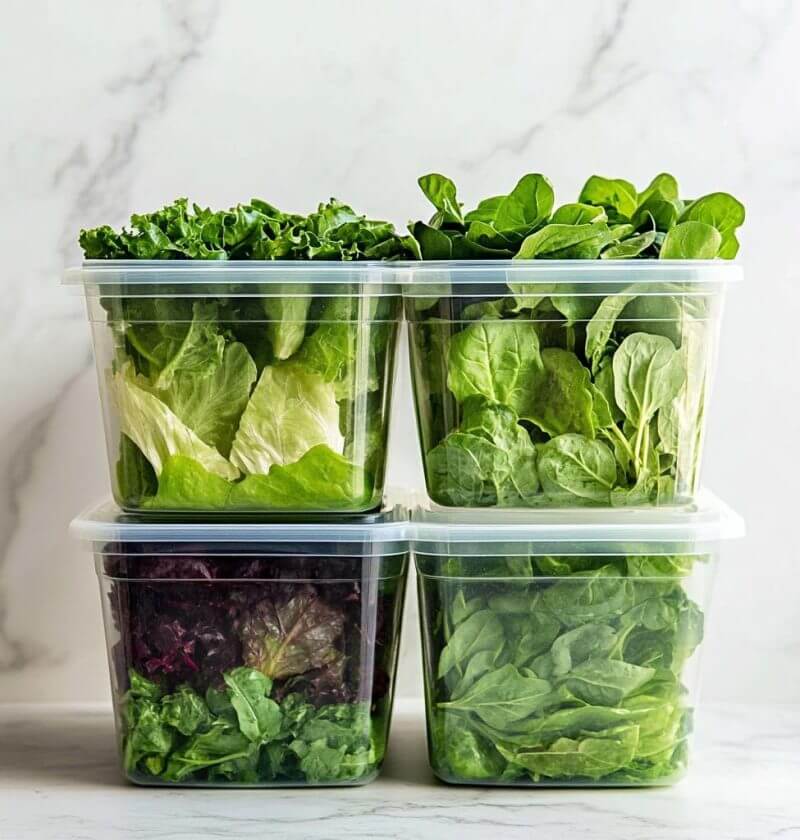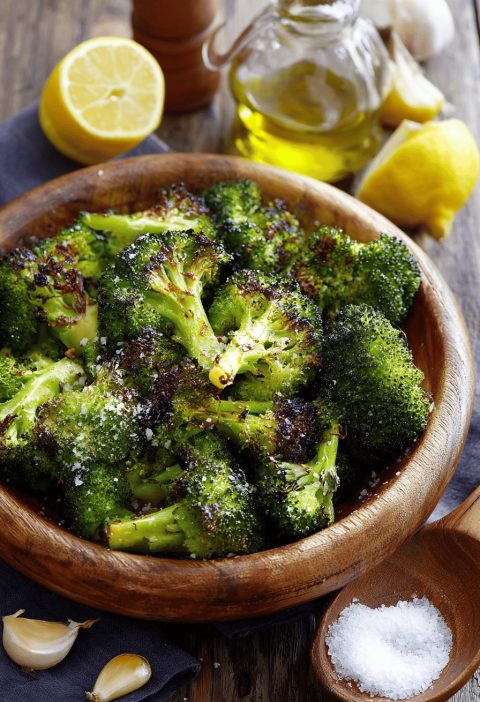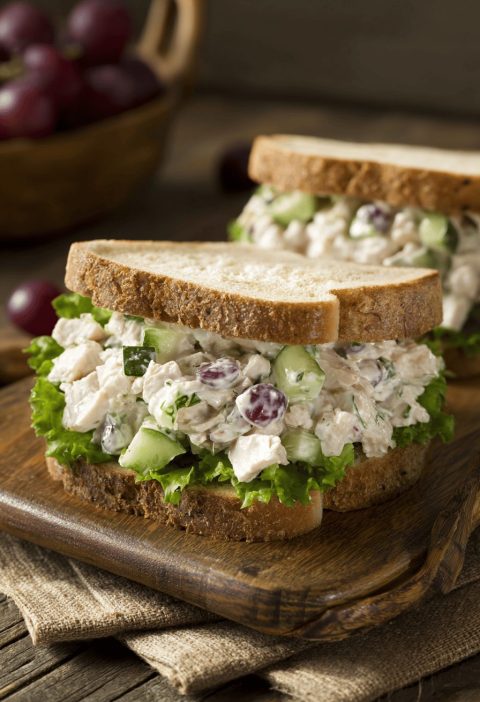Would you like to save this?
Salad greens bring a crisp, refreshing element to every meal, not to mention a host of essential nutrients. But keeping them fresh can feel like a losing battle. One minute they’re vibrant and crunchy, and the next, they’re wilted, slimy, and destined for the trash. If you’re tired of throwing away spoiled greens or constantly running to the store for fresh ones, you’re not alone.
The good news? There’s an easy trick that can keep your greens fresh for up to two weeks or more—and it takes almost no effort. This method is a family secret passed down from my nana, and it’s been a game-changer in my kitchen. With just a little preparation and the right storage method, you can say goodbye to soggy greens and hello to fresh salads anytime you want. Ready to learn the trick? Let’s dive in!
Why Do Salad Greens Spoil So Quickly?
Salad greens are delicate by nature. They contain a lot of water, which means they can quickly lose their freshness if they aren’t stored correctly. Moisture is the main culprit. When there’s too much humidity in your greens’ storage container, it encourages bacterial growth, which leads to that unpleasant slimy texture. On the other hand, lack of proper airflow or overcrowding can also cause them to wilt.
The key to extending the life of salad greens is to control moisture and air exposure, and that’s exactly what this method does. Let’s walk through the steps to keep your greens crisp and delicious for longer.
Step 1: Prepare Your Greens
First, it’s important to give your greens a good rinse. Even pre-washed greens can carry dirt, pesticides, or bacteria that may shorten their shelf life.
- Wash your greens thoroughly under cool water to remove any dirt or chemical residues.
- Dry them completely. This is essential—any leftover moisture can accelerate spoilage. The best tool for this job is a salad spinner since it removes water without damaging the leaves.
- If you don’t have a salad spinner, lay the greens on a clean kitchen towel or pat them dry with paper towels. Make sure they’re as dry as possible before moving on to the next step.
Step 2: Use the Right Storage Container
Choosing the right container is critical to keeping your greens fresh. You want a container that is large enough to hold your greens without squishing or compressing them, which can cause bruising. A large, airtight container works best for this.
- Line the bottom of the container with paper towels. These towels will absorb excess moisture, preventing it from building up around the greens. This small step makes a huge difference in extending the life of your salad.
- If you prefer to avoid single-use paper towels, a reusable kitchen towel or dry tea cloth will also do the trick.
Step 3: Layer the Greens for Maximum Freshness
Now it’s time to arrange your salad greens inside the container.
- Lay the greens loosely on top of the paper towels. Don’t pack them in too tightly—greens need a bit of airflow to stay crisp.
- Once you’ve added all your greens, place another layer of paper towels on top. This helps absorb additional moisture from above.
- Seal the container with its lid, ensuring it’s airtight. Properly sealed containers slow down the exposure to air, which keeps your greens from wilting too soon.
Step 4: Keep Greens Fresh in the Fridge
Now that your greens are safely stored, place the container in the refrigerator. The cooler temperature will slow down the natural breakdown of the leaves, helping them stay fresh for longer.
- Check the paper towels every few days. If they become damp, replace them with fresh, dry paper towels. Keeping moisture under control is the most important part of this method.
- Avoid overcrowding your fridge. Greens need a bit of breathing room, so make sure the container isn’t wedged between other items. Ideally, keep them in a crisper drawer if your fridge has one, as it’s designed to regulate humidity levels.
Why This Method Works So Well
This method is effective because it tackles the two biggest enemies of salad greens: moisture and poor airflow. Excess moisture leads to slimy leaves, while lack of airflow causes the greens to wilt. By using paper towels to wick away moisture and storing the greens loosely in a sealed container, you create the perfect balance. Your greens stay hydrated without becoming soggy, and they have just enough space to prevent bruising or compression.
Bonus Tips for Even Longer Freshness
- Don’t wash greens until you’re ready to store them. The sooner you dry and store your greens after washing, the longer they’ll stay fresh.
- Mixing greens? Store sturdier greens (like kale or romaine) separately from more delicate ones (like arugula or spring mix) for best results.
- Store spinach separately. Spinach tends to release more moisture than other greens, so it’s a good idea to give it its own container to avoid affecting other leafy greens.
Frequently Asked Questions
1. How long will greens stay fresh using this method?
If stored correctly, your salad greens can last up to two weeks or more. The exact duration will depend on the type of greens, but most varieties should stay crisp well beyond the typical 3-5 days.
2. Can I use this method for pre-packaged greens?
Yes! Even if your greens come pre-washed, it’s a good idea to rinse them again and store them using this method. This will help them stay fresh much longer than if you leave them in their original packaging.
3. What if my greens are already starting to wilt?
If your greens are slightly wilted, you can revive them by soaking them in cold water for 10-15 minutes. After soaking, dry them thoroughly and store them using the paper towel method.
4. Can I use cloth towels instead of paper towels?
Absolutely! A clean, dry cloth towel works just as well as paper towels. Just be sure to wash and replace the towel as needed to prevent any buildup of moisture.
5. Can I freeze salad greens?
Freezing is not ideal for delicate greens meant for salads, as they’ll lose their texture. However, you can freeze heartier greens like spinach or kale if you plan to use them in smoothies or cooked dishes.
Final Thoughts
With this simple yet effective method, you’ll never have to deal with wilted, slimy salad greens again. By controlling moisture with paper towels and giving your greens enough room to breathe, you’ll extend their shelf life and save yourself from unnecessary waste. It only takes a few minutes to prepare, and the results are well worth the effort.
So, next time you bring home a bag of salad greens, try out this technique. You’ll be amazed at how crisp and fresh your greens stay—even two weeks later. No more rushed salads or throwing away spoiled lettuce. Instead, enjoy fresh, vibrant greens anytime you want, and reduce your grocery runs and food waste along the way!







